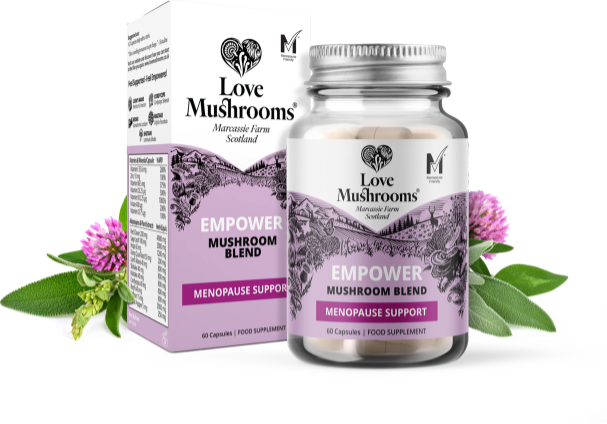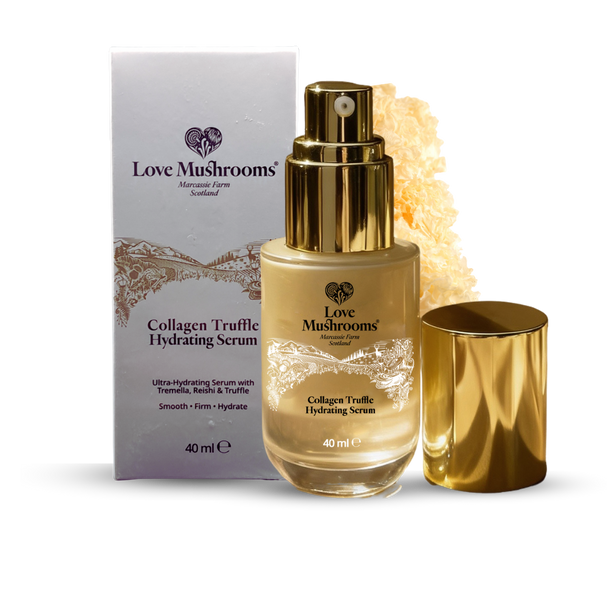Best Sellers
Discover the Power of Mushroom Food Supplements, explore our latest selection of high-quality products, harnessing the natural benefits of mushrooms for enhanced well-being.
FOCUS – Lion’s Mane + Ashwagandha (60 Capsules)
Empower – Mushroom Blend for Menopause Support (60 Capsules)
Cordyceps Liquid Drops (50ml)
AS FEATURED IN
Easy to order
Easy to order, arrive quickly and brilliant products. I use the lions mane to help manage my adhd symptoms. And for many other reasons. It's a game changer.
Excellent
Have purchased supplements over the last year or so and can whole heartedly recommend them.
Great Customer Service!
Very effective products and great personal customer service. I no longer need my prescription meds for anxiety. I have Lions mane and Reishi tincture. Thankyou! 😊
Finally able to focus
I've tried for 3 days now I can tell I felt more concentrated since the first day. I love the way feel been able to focus in one thing at a time :) Thank you so much
SHOP BY MUSHROOM

Our state-of-the-art ultrasonic extraction process maximises the potency and bioavailability of Lion’s Mane’s beneficial compounds. By utilising precise high-frequency sound wa...
Lion’s Mane Liquid Drops (50ml)
4000mg per Dose

Why Lion’s Mane?
Renowned in traditional Eastern medicine, Lion’s Mane is increasingly popular among those looking to support their holistic well-bein...
Lion’s Mane Capsules (60)
4000mg per Capsule

Why Lion’s Mane?
Renowned in traditional Eastern medicine, Lion’s Mane is increasingly popular among those looking to support their holistic well-being...
Lion’s Mane Capsules (30)
4000mg per Capsule

Our state-of-the-art ultrasonic extraction process maximises the potency and bioavailability of Lion’s Mane’s beneficial compounds. By utilising precise high-frequency sound wa...
Lion’s Mane Liquid Drops (30ml)
4000mg per Dose

Key Ingredients Explained:
-
- Lion’s Mane, Shiitake, Maitake, Cordyceps & Reishi Mushrooms: Cel...
Empower – Mushroom Blend for Menopause Support (60 Capsules)

Key Ingredients Explained:
- Lion’s Mane, Maitake, Cordyceps & Reishi Mushrooms: Revered adaptogenic mushrooms traditionally used to natura...
Empower – Mushroom Blend for Perimenopause Support (60 Capsules)

Crafted for Balanced Wellness and Daily Vitality
Boost your everyday well-being with our carefully formulated FOCUS ...
FOCUS – Lion’s Mane + Magnesium (60 Capsules)

Key Ingredients Explained:
- Lion’s Mane Mushroom (2000mg): Revered in traditional Chinese medicine, Lion’s Mane is celebrated for its unique com...
FOCUS – Lion’s Mane + Ashwagandha (30 Capsules)

Experience natural clarity, calm, and vitality in one beautifully balanced drink.
Thoughtfully crafted for women navigating the hormonal shifts of men...
Empower – Menopause Decaf Coffee Boost

Key Ingredients Explained:
- Lion’s Mane Mushroom (2000mg): Revered in traditional Chinese medicine, Lion’s Mane is celebrated for its unique com...
FOCUS – Lion’s Mane + Ashwagandha (60 Capsules)

Our state-of-the-art ultrasonic extraction process maximises the potency and bioavailability of Cordyceps’ beneficial compounds. By utilising precise high-frequency sound waves...
Cordyceps Liquid Drops (50ml)
4000mg per Dose

Why Cordyceps?
Renowned in traditional Chinese herbalism, Cordyceps mushroom has long been prized by those looking to naturally support their vitality...
Cordyceps Capsules (60)
4000mg per Capsule

Our state-of-the-art ultrasonic extraction process maximises the potency and bioavailability of Cordyceps’ beneficial compounds. By utilising precise high-frequency sound waves...
Cordyceps Liquid Drops (30ml)
4000mg per Dose

Key Ingredients Explained:
-
- Lion’s Mane, Shiitake, Maitake, Cordyceps & Reishi Mushrooms: Cel...
Empower – Mushroom Blend for Menopause Support (60 Capsules)

Key Ingredients Explained:
- Lion’s Mane, Maitake, Cordyceps & Reishi Mushrooms: Revered adaptogenic mushrooms traditionally used to natura...
Empower – Mushroom Blend for Perimenopause Support (60 Capsules)

Why Cordyceps?
Renowned in traditional Chinese herbalism, Cordyceps mushroom has long been prized by those looking to naturally support their vitality...
Cordyceps Capsules (30)
4000mg per Capsule

Experience natural clarity, calm, and vitality in one beautifully balanced drink.
Thoughtfully crafted for women navigating the hormonal shifts of men...
Empower – Menopause Decaf Coffee Boost

Experience natural clarity, calm, and vitality in one beautifully balanced drink.
Thoughtfully crafted for women navigating the hormonal shifts of per...
Empower – Perimenopause Decaf Coffee Boost

Key Ingredients Explained:
- Lion’s Mane, Cordyceps & Reishi Mushrooms: Revered adaptogenic mushrooms traditionally used to naturally suppo...
Empower – Mushroom Blend for PMS Support (60 Capsules)

Our state-of-the-art ultrasonic extraction process maximises the potency and bioavailability of Reishi’s beneficial compounds. By utilising precise high-frequency sound waves, ...
Reishi Liquid Drops (50ml)
4000mg per Dose

Why Reishi?
Deeply respected in traditional Eastern medicine, Reishi mushroom is increasingly popular among individuals exploring natural ways to supp...
Reishi Capsules (60)
4000mg per Capsule

Key Ingredients Explained:
-
- Lion’s Mane, Shiitake, Maitake, Cordyceps & Reishi Mushrooms: Cel...
Empower – Mushroom Blend for Menopause Support (60 Capsules)

Key Ingredients Explained:
- Lion’s Mane, Maitake, Cordyceps & Reishi Mushrooms: Revered adaptogenic mushrooms traditionally used to natura...
Empower – Mushroom Blend for Perimenopause Support (60 Capsules)

Why Reishi?
Deeply respected in traditional Eastern medicine, Reishi mushroom is increasingly popular among individuals exploring natural ways to supp...
Reishi Capsules (30)
4000mg per Capsule

Experience natural clarity, calm, and vitality in one beautifully balanced drink.
Thoughtfully crafted for women navigating the hormonal shifts of men...
Empower – Menopause Decaf Coffee Boost

Experience natural clarity, calm, and vitality in one beautifully balanced drink.
Thoughtfully crafted for women navigating the hormonal shifts of per...
Empower – Perimenopause Decaf Coffee Boost

Key Ingredients Explained:
- Lion’s Mane, Cordyceps & Reishi Mushrooms: Revered adaptogenic mushrooms traditionally used to naturally suppo...
Empower – Mushroom Blend for PMS Support (60 Capsules)

Key Ingredients Explained:
- Lion’s Mane, Maitake, Cordyceps & Reishi Mushrooms: Revered adaptogenic mushrooms traditionally used to natura...
Empower – Mushroom Blend for Perimenopause Support (60 Capsules)

Key Ingredients Explained:
-
- Lion’s Mane, Shiitake, Maitake, Cordyceps & Reishi Mushrooms: Cel...
Empower – Mushroom Blend for Menopause Support (60 Capsules)

Experience natural clarity, calm, and vitality in one beautifully balanced drink.
Thoughtfully crafted for women navigating the hormonal shifts of men...
Empower – Menopause Decaf Coffee Boost

Experience natural clarity, calm, and vitality in one beautifully balanced drink.
Thoughtfully crafted for women navigating the hormonal shifts of per...
Empower – Perimenopause Decaf Coffee Boost

Key Ingredients Explained:
-
- Lion’s Mane, Shiitake, Maitake, Cordyceps & Reishi Mushrooms: Cel...
Empower – Mushroom Blend for Menopause Support (60 Capsules)

Experience natural clarity, calm, and vitality in one beautifully balanced drink.
Thoughtfully crafted for women navigating the hormonal shifts of men...
Empower – Menopause Decaf Coffee Boost

This bundle brings together two of the most respected mushrooms in the wellness world:
- Lion’s Mane – A favourite among students and professio...
Energy & Focus Bundle 30ml

Key Ingredients Explained:
Snow Mushroom (Tremella):
Nature’s answer to hyaluronic acid, Tremella holds up to 500 times it...
Collagen Truffle Face Mask Set of 5

Key Ingredients Explained:
Snow Mushroom (Tremella):
Nature’s answer to hyaluronic acid, Tremella holds up to 500 times it...
Collagen Truffle Face Mask

Key Ingredients Explained:
Snow Mushroom (Tremella):
Nature’s answer to hyaluronic acid, Tremella holds up to 500 times it...
Collagen Truffle Moisturising Cream

This collection celebrates vegan, cruelty-free and paraben-freeformulations that are as luxurious as they are effective — all housed in elegant glass vessels with luminous gold...
The Love Mushrooms Ultimate Ritual Set

Key Ingredients Explained:
Snow Mushroom (Tremella):
Nature’s answer to hyaluronic acid, Tremella holds up to 500 times it...
Collagen Truffle Hydrating Serum

Key Ingredients Explained:
Snow Mushroom (Tremella):
Nature’s answer to hyaluronic acid, Tremella holds up to 500 times it...
Collagen Truffle Face Mask

Key Ingredients Explained:
Snow Mushroom (Tremella):
Nature’s answer to hyaluronic acid, Tremella holds up to 500 times it...
Collagen Truffle Face Mask Set of 5

Key Ingredients Explained:
Snow Mushroom (Tremella):
Nature’s answer to hyaluronic acid, Tremella holds up to 500 times it...
Collagen Truffle Moisturising Cream

This collection celebrates vegan, cruelty-free and paraben-freeformulations that are as luxurious as they are effective — all housed in elegant glass vessels with luminous gold...
The Love Mushrooms Ultimate Ritual Set

Key Ingredients Explained:
Snow Mushroom (Tremella):
Nature’s answer to hyaluronic acid, Tremella holds up to 500 times it...












